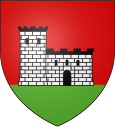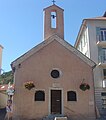Veynes
|
Veynes Vèina |
||
|---|---|---|

|
|
|
| region | Provence-Alpes-Cote d'Azur | |
| Department | Hautes-Alpes | |
| Arrondissement | Gap | |
| Canton | Veynes (main town) | |
| Community association | Buëch-Dévoluy | |
| Coordinates | 44 ° 32 ' N , 5 ° 49' E | |
| height | 771-1,815 m | |
| surface | 42.6 km 2 | |
| Residents | 3,182 (January 1, 2017) | |
| Population density | 75 inhabitants / km 2 | |
| Post Code | 05400 | |
| INSEE code | 05179 | |
| Website | www.ville-veynes.fr | |
 Castle Château de La Villette (now the town hall) |
||
Veynes ( Occitan : Veina ) is a French commune of the department of Hautes-Alpes in the region of Provence-Alpes-Cote d'Azur . It is assigned to the Arrondissement of Gap and the canton of Veynes , of which it is the capital .
geography
The mountain village with 3182 inhabitants (as of January 1, 2017) is located on the right bank of the wild river Petit Buëch , around 20 kilometers northwest of Gap and around 75 kilometers south of Grenoble .
economy
Although Veynes was on a trade route from Lyon via Grenoble to Provence , the small town did not develop noticeably. In addition to agriculture, which served the local and regional markets, handicraft products made of wool and leather were predominant until the 19th century. This changed with the arrival of the railroad. Adrien Ruelle (1815–1887), who was born in Veynes and director of the Compagnie des chemins de fer de Paris à Lyon et à la Méditerranée (PLM), chose Veynes as the railway junction of the two lines Marseille - Grenoble and Livron - Briançon . The first line from Marseille to Veynes was completed in 1875 and the city received a locomotive workshop. Up until the electrification of the railway, Veynes remained a railway town, with the railway industry feeding up to 700 families in its boom years. The route to the seaport of Marseille was of outstanding importance for freight and passenger traffic at that time, as all of North West Africa was owned by France.
From 1976 the use of solar energy was strongly promoted under the direction of the deputy mayor Madeleine Roux. This project was abruptly stopped in 1983 under the newly elected administration. Today Veynes lives from small businesses and local agriculture. There are also efforts to promote tourism. Veynes is known for its fruit brandies , with the pear brandy ( Eau-de-vie de poire ) being the flagship.
history
Antiquity
Because of its geographical location, Veynes, which was called Davianum or Mutatio Daviano in Gallo-Roman times , was a transit point from an early age. Davianum was on a side street of the Via Domitia , which branched off at Vapincum (today Gap ) to Orange . Remains of this Roman road , which was called Via Cottia , are still clearly visible at the entrance to the village.
middle Ages
In the High Middle Ages , the parish grew around the parish church of the Saint-Sauveur priory . The castle of the Dauphin von Viennois dominated the cityscape. Veynes was an allodial rule that was directly subordinate to the Dauphin. The citizens of the city were exposed not only to his whims, but also to those of the De Poitiers family , who had taken the territory from the indebted Dauphin as pledge. On November 17, 1296, the townspeople demanded free access to the watercourses and the abolition of the mill compulsory and other freedoms from the local vassals of the Dauphin , but the co-seigneurs were not authorized to grant such rights. In 1322 another major conflict arose, this time with the Carthusian monks of Durbon, who claimed part of the municipality for themselves. In the 14th century a community from Lombardy settled in the city and opened a mint there. During the plague wave of 1345, the Jewish community was used as a scapegoat and was almost wiped out in the region. At the end of the 15th century, passing mercenaries from the French Italian army devastated the area.
Modern times
With the 16th century, the cityscape changed radically. The two castle districts - the Bourg Neuf in the east and the fortified castle La Vilette in the west - which were separated by the Gleizette torrent , united. A street, the Rue Sous le Barry, was driven under the castle wall . The wealthy among the citizens built elegant houses along this street, of which the Hôtel du Lion d'or is decorated with stucco . Today this passage, which became the main artery of the old town, is called Rue Jean-Jaurès . During construction work in 2010, the old, paved street came out again.
Under the reign of King Charles IX. the wars of religion reached the area from 1562 (→ Huguenot Wars ). On February 22, 1572, just a few months before the Paris massacre known as St. Bartholomew's Night, the city's Protestants were given permission to practice their faith in La Villette Castle . The majority of the bourgeoisie and the nobility then transferred to the reformed camp, which, however, did not take place without violent skirmishes . In 1685, the Edict of Fontainebleau revoked the freedom of belief that the Huguenots were guaranteed in the Edict of Nantes . The staunch Protestants of Veynes felt compelled to exile. They found a new home in the Calvinist Republic of Geneva , in Switzerland's cantons that had become Protestant , in Brandenburg-Prussia or in Holland . This exodus was also a great economic loss for Veynes, because many of the emigrants proved to be capable and successful abroad: Abraham Patras, once royal notary of Veynes, became governor-general of the Dutch East Indies , Jacques de Maffé became a master watchmaker in Geneva, and the merchant Salomon Jordan from Veynes pastor of the city of Bützow and the pharmacist Jacques Galland was involved in the founding of Bad Karlshafen .
In the course of the Palatinate War of Succession, the French army overran large parts of Savoy-Piedmont in 1692, whereupon the Duke of Savoy invaded the Dauphiné in retaliation and devastated the country there. For Veynes this was a disaster: A fire damaged Bourg Neuf Castle and La Villette Castle was even half destroyed. In the following 18th century the city stagnated at a modest level. This only changed with the French Revolution . Thanks to the nationalization of the property of the nobility and the clergy, a new cemetery could finally be built just outside and the church district in the city center relieved. The Montagne de Tombarel part of the municipality became the commons and the bourgeoisie, to which political power now belonged, sent their children to modern schools.
coat of arms
Blazon : In red on a green shield base an openwork silver tower - walled in black and crowned by five black battlements; On the left (heraldic) there is also a silver wall - open, pierced, walled in black and crowned by four battlements.
Population development
| year | 1962 | 1968 | 1975 | 1982 | 1990 | 1999 | 2009 | 2016 |
|---|---|---|---|---|---|---|---|---|
| Residents | 3474 | 3578 | 3300 | 3178 | 3148 | 3093 | 3166 | 3161 |
Attractions
- The 15th century castle Château de La Villette is flanked by the city gate and a round tower. Today it serves as the town hall.
- On the Place Adrien-Ruelle there is a fountain adorned with a bust of the railway pioneer Adrien Ruelle. The square was previously called Place Grenette (Kornplatz) and was built on the site of the former city gate Porte Ayguière (also Porte Eyguière ). The fountain goes back to the year 1687.
- The Roman road along the northeastern municipal border was a section of the Voie des Alpes that connected Valence with Montgenèvre . It served as a traffic route towards the Gap until the middle of the 18th century.
- The chapel Chapelle Notre Dame de Pitié (Chapel of Our Lady of Mercy)
Individual evidence
- ^ Les chemins de fer dans les Alpes du Sud: passé, present, avenir . In: J. Guiter: Revue de geographie alpine , 1976.
- ↑ "We have decided to settle the French in Bützow" - 300 years of Huguenots in Mecklenburg (PDF file; 92 kB)
- ^ Huguenot Museum - Bad Karlshafen





